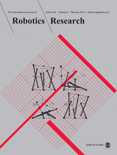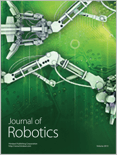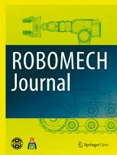
INTERNATIONAL JOURNAL OF ROBOTICS RESEARCH
Scope & Guideline
Unveiling the Future of Robotics Research
Introduction
Aims and Scopes
- Robotic Perception and Navigation:
Research in this area includes advancements in visual odometry, SLAM (Simultaneous Localization and Mapping), and sensor fusion techniques that enable robots to understand and navigate their environments efficiently. - Robot Learning and Adaptation:
This scope covers machine learning approaches applied to robotics, including reinforcement learning, imitation learning, and adaptive control strategies that allow robots to improve their performance through experience. - Manipulation and Grasping:
Papers in this area focus on robotic manipulation techniques, including grasping strategies, force control, and dexterous manipulation of objects across various environments. - Soft Robotics and Bio-inspired Design:
This unique contribution includes research on soft actuators, compliant robots, and biologically inspired designs that enhance the versatility and safety of robotic systems in human-robot interactions. - Multi-Robot Systems and Coordination:
Research on collaborative robotics, including coordination strategies for multi-robot systems, decentralized control, and task allocation methodologies. - Modeling and Control of Robotic Systems:
This area encompasses theoretical frameworks and algorithms for the modeling and control of robotic systems, ensuring stability and performance in dynamic and uncertain environments.
Trending and Emerging
- Integration of Machine Learning in Robotics:
There is a growing trend towards incorporating machine learning techniques in various aspects of robotics, from perception to control, enabling smarter and more adaptable robotic systems. - Soft Robotics and Compliant Mechanisms:
Research in soft robotics is rapidly expanding, focusing on the design and control of soft actuators and robots that can safely interact with humans and navigate unstructured environments. - Human-Robot Interaction (HRI):
The exploration of social and physical interactions between robots and humans is gaining prominence, addressing challenges in collaborative robots (cobots) and socially aware robotic systems. - Robotic Perception and Multi-Sensor Fusion:
Advancements in robotic perception, particularly using multi-sensor fusion techniques (such as visual-inertial and LiDAR integration), are increasingly featured, reflecting the need for robust navigation and environmental understanding. - Autonomous Systems and Self-Driving Technologies:
Research focusing on autonomous systems, including self-driving vehicles and aerial drones, is trending, driven by significant advancements in algorithms and sensor technologies that enhance autonomy.
Declining or Waning
- Traditional Rigid Robotics:
Research focused on traditional rigid robotic systems and their applications seems to be declining, possibly due to the increasing interest in soft robotics and adaptive systems that can better interact with humans and navigate complex environments. - Basic Motion Planning Algorithms:
There appears to be a decreasing emphasis on basic motion planning algorithms that do not incorporate advanced learning techniques or adaptive strategies, as the field moves towards more sophisticated planning that incorporates learning from experience. - Static Sensor Systems:
The reliance on static sensor systems without integration of advanced perception techniques is waning, as the field shifts towards dynamic and adaptive sensor fusion approaches that enhance robot perception capabilities.
Similar Journals

Cyborg and Bionic Systems
Connecting Minds: Where AI Meets Biomedical InnovationCyborg and Bionic Systems, published by the American Association for the Advancement of Science, stands as a pivotal open access journal that has enriched the academic landscape since its inception in 2020. With an E-ISSN of 2692-7632, this journal focuses on interdisciplinary research that converges on advances in Artificial Intelligence, Biomedical Engineering, Human-Computer Interaction, and Mechanical Engineering. Notably, the journal has attained impressive rankings, securing Q1 status across these categories and exhibiting a commendable Scopus ranking with percentile standouts in each discipline, thus establishing its influence and relevance in the scientific community. Based in Washington, DC, this journal provides a platform for innovative ideas and findings that aim to enhance our understanding of cyborg systems and bionic devices. The open access model ensures that groundbreaking research is readily available to researchers, professionals, and students alike, fostering collaboration and knowledge dissemination within these rapidly evolving fields.

Unmanned Systems
Leading the Charge in Autonomous Vehicle AdvancementsUnmanned Systems is a leading academic journal published by WORLD SCIENTIFIC PUBL CO PTE LTD based in Singapore, that serves as a premier platform for research and advancements in unmanned vehicle technology. Covering a broad range of disciplines, the journal ranks in the Q1 category for Aerospace Engineering, Automotive Engineering, Control and Optimization, and Control and Systems Engineering as of 2023, showcasing its high impact within these fields. With impressive Scopus rankings placing it in the top tiers of its categories—8th in Control and Optimization and 14th in Aerospace Engineering—Unmanned Systems stands out as a vital resource for researchers, professionals, and students eager to explore current trends and innovations. While the journal operates under a traditional access model, it remains committed to disseminating quality original research, reviews, and case studies that contribute significantly to the understanding and application of unmanned technologies from 2013 through 2024.

Journal of Robotics
Pioneering Innovations in Autonomous SystemsJournal of Robotics, published by HINDAWI LTD, is a premier open-access journal dedicated to the rapidly evolving field of robotics. With its ISSN 1687-9600 and E-ISSN 1687-9619, the journal has been an essential resource for researchers, professionals, and students since its establishment in 2009. Based in England, the journal not only aims to disseminate cutting-edge research but also provides a platform for critical discussions on the latest advancements in robotics. Recognized for its quality, the journal holds a Q2 ranking in Computer Science (miscellaneous) and a Q3 ranking in Control and Systems Engineering for the year 2023. Spanning topics from autonomous systems to robotic engineering, the Journal of Robotics is indexed in various esteemed databases, making it a credible source for innovative research. The journal's commitment to open access ensures that its research reaches a broad audience, encouraging collaboration and driving forward the boundaries of technology and engineering.

ROBOMECH Journal
Advancing Robotics and Mechanical Engineering through Open ResearchROBOMECH Journal, published by SpringerNature, is a prominent open-access journal dedicated to the fields of robotics, mechanical engineering, and artificial intelligence. Established in 2014, the journal has quickly established itself as a vital platform for disseminating innovative research in control and optimization, instrumentation, and modeling and simulation, earning a commendable Q2 ranking in Mechanical Engineering and multiple Q3 rankings across other relevant fields in 2023. With a commitment to facilitating accessible knowledge sharing, ROBOMECH Journal promotes cutting-edge research that drives advancements in both theoretical frameworks and practical applications within the robotics community. Scholars, engineers, and professionals seeking to contribute to or stay informed about the latest developments in these dynamic fields will find the journal's rich array of articles invaluable. With its open-access model, all published research is freely available, ensuring wide dissemination and increased visibility for authors, thus fostering collaboration and innovation across disciplines.

Journal of Micro-Bio Robotics
Exploring the Future of Robotics and BiologyThe Journal of Micro-Bio Robotics, published by SPRINGER HEIDELBERG, is an esteemed periodical dedicated to the dynamic intersection of robotics and biological systems. With an ISSN of 2194-6418 and an E-ISSN of 2194-6426, this journal spans a broad spectrum of interdisciplinary research from 2013 to 2024, reflecting its commitment to advancing knowledge in fields such as biomedical engineering, biotechnology, electrical and electronic engineering, materials science, and mechanical engineering. This journal holds a Q4 ranking in Biomedical Engineering and a Q3 ranking in several other critical categories, demonstrating its growing influence within the scientific community. The journal serves as a vital resource for researchers, professionals, and students aiming to explore cutting-edge developments in micro-bio robotics, providing a platform for high-impact research that helps facilitate innovation and collaboration in this emerging field. While currently not offering Open Access options, the journal's rigorous peer-review process ensures the highest quality of published work, making it an essential tool for anyone looking to stay abreast of advancements in micro-bio robotic technology.

International Journal of Intelligent Robotics and Applications
Innovating Intelligent Solutions for TomorrowInternational Journal of Intelligent Robotics and Applications, published by SPRINGER SINGAPORE PTE LTD, is a pivotal platform dedicated to advancing the field of robotics and artificial intelligence. With an ISSN of 2366-5971 and an E-ISSN of 2366-598X, this journal has established its presence since its inception in 2017, showcasing innovative research and applications up until 2024. The journal aims to foster interdisciplinary collaboration by publishing high-quality articles that cover a broad range of topics from foundational AI concepts to cutting-edge robotics technologies. It holds respectable rankings, positioned in the Q3 category of Artificial Intelligence and Q2 category of Computer Science Applications in the 2023 metrics, and is indexed in Scopus with notable rankings in both computer science disciplines. Although it follows a subscription model, the journal remains committed to facilitating access to groundbreaking research for its audience of researchers, professionals, and students, contributing to the ever-evolving landscape of intelligent robotics.

Robotic Intelligence and Automation
Advancing Knowledge in Intelligent Automation.Robotic Intelligence and Automation is a pioneering academic journal dedicated to the exploration and advancement of knowledge within the realms of robotics, artificial intelligence, and automation technologies. Published by EMERALD GROUP PUBLISHING LTD in the United Kingdom, this journal serves as a critical platform for researchers, professionals, and students who strive to understand and innovate in these rapidly evolving fields. With an impressive visibility across multiple disciplines, it has achieved a respectable Q2 ranking in Computer Science Applications, Control and Systems Engineering, Electrical and Electronic Engineering, and Industrial and Manufacturing Engineering, while also being recognized in Q3 for Artificial Intelligence and Human-Computer Interaction. The journal boasts a comprehensive Open Access model, allowing broad dissemination of research findings, which is vital for fostering collaboration and learning within the scientific community. Researchers can look forward to contributing to a publication that not only addresses current challenges but also seeks to shape the future of intelligent automation and robotics.

ADVANCED ROBOTICS
Shaping Tomorrow’s Robotics LandscapeADVANCED ROBOTICS is a premier journal published by Taylor & Francis Ltd that has been at the forefront of robotics research since its inception in 1986. With an esteemed ISSN of 0169-1864 and E-ISSN of 1568-5535, this journal offers a unique platform for disseminating high-quality research across diverse domains within the robotics field, encompassing applications in Computer Science, Control and Systems Engineering, Hardware and Architecture. Ranked in the Q2 quartile across multiple categories in 2023, ADVANCED ROBOTICS maintains a reputable standing in the academic community, emphasizing its commitment to advancing knowledge and innovation. Although not an Open Access publication, the journal’s access options ensure that subscribers can explore the latest findings and engage with prominent experts in the field, facilitating an enriching exchange of ideas. Researchers, professionals, and students alike will find ADVANCED ROBOTICS an invaluable resource for keeping abreast of developments and contributing to the ever-evolving landscape of robotics.

Robotics, published by MDPI in Switzerland, stands at the forefront of interdisciplinary research, focusing on the latest advancements in robotics, artificial intelligence, control systems, and mechanical engineering. As an Open Access journal since 2012, it aims to disseminate high-quality research and innovative findings to a global audience, promoting collaboration among researchers, professionals, and students alike. With a commendable impact reflected in its 2023 categorizations—including Q2 rankings in Artificial Intelligence and Control and Optimization, and a prestigious Q1 in Mechanical Engineering—the journal underscores its significance within the scientific community. Notably, it boasts impressive Scopus rankings, standing within the top 20% in Mathematics and Control and Optimization. Robotics is dedicated to advancing knowledge and practice in the robotics domain, providing readers with valuable insights into emerging trends and technologies that shape the future of the field.

Journal of Control Science and Engineering
Elevating Knowledge in Control Science and ApplicationsThe Journal of Control Science and Engineering, published by HINDAWI LTD, is a prominent open-access journal that has been disseminating pioneering research since 2007. With its ISSN 1687-5249 and E-ISSN 1687-5257, the journal serves as a crucial platform for researchers, professionals, and students engaged in the fields of Computer Science Applications, Electrical and Electronic Engineering, and Modeling and Simulation. Holding a Q3 quartile ranking in 2023 across these categories, the journal maintains rigorous academic standards and is recognized for its contributions to advancing knowledge and technology in control science. The journal's current Scopus rankings highlight its significance, with impressive percentiles placing it within the top tier of its fields. Readers can access a wide range of high-quality research articles through its open access model, further establishing the journal as an essential resource for anyone seeking to broaden their understanding and application of control principles.